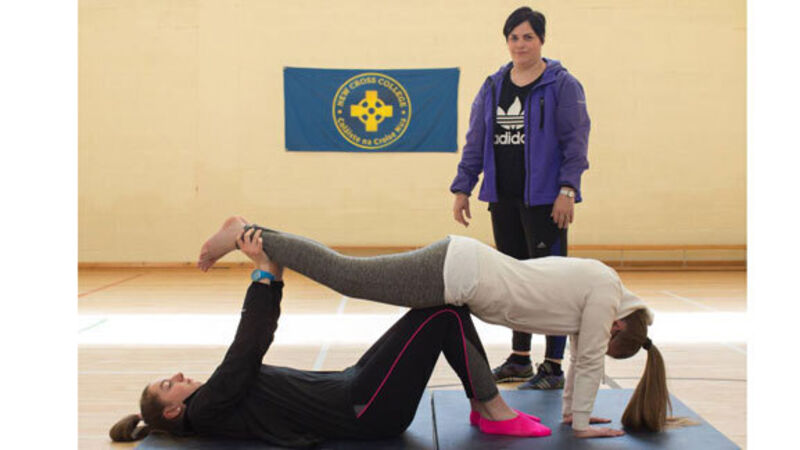Gender balance is needed when it comes to physical education

LAURYN GROOME used to feel self-conscious in Physical Education (PE) class. So did her friends.
“Everyone would sit with their friend and if they weren’t doing PE you wouldn’t either. You’d only go into a game with your friends. There were girls who had different body shapes — you’d think ‘oh, I’m not like her, I don’t want to do PE’.”
When the 14-year-old’s school in Finglas amalgamated with a local boys’ school last September, PE teachers Eimear Cullen and Cathal Byrd wanted to boost PE participation.
“There was a cohort of girls who weren’t keen — they’d turn up without their PE gear. The perception was PE was only for the sporty people. The girls were quite body-conscious,” says Ms Cullen. Other barriers, she says, included girls not seeing sport as relevant to their lives, as well as not liking to sweat or having period issues.
She started by letting the girls wear whatever they felt comfortable in for PE class — tracksuit, leggings. She and Mr Byrd tailored a special PE programme.
“There was no point in our starting with something highly-skilled like soccer. We eased them in gently, with activities like unihoc, ultimate Frisbee, acrobatics, badminton, adventure education and team challenges.”
Ms Cullen sees PE as much broader than just picking a team — she aims to create a culture where the less sporty don’t feel deflated by the elite players.
“It’s great to get on a team but I don’t fuss about it — you’ll lose half the kids who aren’t into competitive sports. For me, the sporty girls sell the subject. I empower those girls but I don’t highlight them.”
The approach is very much in tune with the Sky Sports Living for Sport programme, which is running in several schools countrywide.
This is a free secondary school initiative that uses sports stars and sports skills to boost confidence, change behaviours, increase attainment and improve life skills. Katie Taylor is an ambassador, while Jenny Murphy from the Irish women’s rugby team is a mentor.
The team consists mostly of girls — 18 girls to six boys. Ms Cullen picked them because they were good PE performers but lacked self-belief.
“My aim was to get them to be happy in their own skin and be confident in a sports setting.”
The team invent their own games and teach them to their peers. In May, they will teach their games to incoming 2015 first years.
Lauryn Groome says many more girls are doing PE now and finding it fun. Their confidence has improved, she says, and they’ve begun to feel more comfortable in their bodies.
It’s a positive turnaround — in stark contrast to findings emerging from Britain where a small study of 38 pupils looked at the activity levels of seven and eight-year-olds and at how they feel about sport, body image and self-esteem.
The study found even girls this young are becoming self-conscious, losing confidence and dropping sport as a result. And both boys and girls were voicing gender stereotypes around sporting ability, saying boys are faster, stronger and sportier than girls and that girls are rubbish at football.
These findings may not translate in the Irish context, suggests Una May, director of participation and ethics at the Irish Sports Council. According to the 2010 Children’s Sport Participation and Physical Activity study, almost 90% of fifth and sixth class pupils regularly play sport outside school.
“Girls are more attracted to individual sports — dance, swimming, horse-riding, aerobics and athletics — whereas boys play more team sports like Gaelic football, soccer or hurling.”
But from this high point, children’s participation in sport wanes. The first drop-off happens when they transition into secondary school, with 80% now involved in sport — this is according to the 2013 Keeping Them in the Game study.
“Drop-off is more significant in the six most popular sports — Gaelic football, hurling, camogie, soccer, swimming and basketball. Kids tend to stick more at minority sports like running, martial arts, horse-riding and aerobics,” says May, adding that fall-off among girls is more pronounced during exam years — a pity because studies show academic performance benefits from sports participation.
Physiotherapist and exercise scientist Avril Copeland says when third-year girls drop out of team sports, they tend to stay out of them whereas they often re-engage with individual sports in transition year.
It’s true that girls in general tend to be more easily put off sport than boys. They’re not quite as engaged as their male counterparts.
Another Irish research study found that 77% of girls agreed that they ‘enjoyed PE’ compared to 86% of boys. Fifty-four percent of girls ‘minded bad weather’ versus 23% of boys; 44% of girls ‘minded getting hot, sweaty and dirty’ compared to 14% of boys; and 45% of girls (versus 29% of boys) ‘minded that they weren’t as good as others at sport’.
The number one bugbear for both genders was being left out of a game — 53% of boys minded this compared with 68% of girls.
Professor Niall Moyna of DCU’s Centre for Preventive Medicine says he has “severe issues” with PE in Irish schools. “It’s not taken seriously. It’s not an examinable subject. You don’t bring a note to get off any other subject. It doesn’t serve the nation’s health needs.”
Moyna believes young girls don’t get why PE is important. He points to a 2010 study, which found pupils got no access to swimming in 85% of secondary schools; 76% of schools don’t have access to dance and 42% don’t have gym access.
These, he says, are all activities young girls would like. “PE has to be made relevant to young girls’ lives,” he insists.
Physiotherapist and exercise scientist Avril Copeland ( www.tickerfit.com ) has these recommendations for parents:
* Be a role model. Set an example by leading an active lifestyle.
* Keep a healthy attitude to sport and exercise. Focus on positive aspects – health benefits, social aspects – rather than focusing on sport as a solution to negative feelings around weight.
* Encourage kids to engage in physical activity from young age — this means 60 minutes of moderate to vigorous intensity activity daily.
* Incorporate physical activity into family life — for example, trail walks at weekends.
* Encourage children to engage in all types of sports — both team and individual. Avoid pigeon-holing kids too early.
* Women’s sport is not covered as much in the media as men’s. Bring your daughter to events where she’ll see strong female role models in sport.
* Be patient. Young girls may go through phases of not engaging with certain sports/activities. Be careful not to criticise or judge. Young girls need to feel supported and encouraged when it comes to sport and physical activity.










